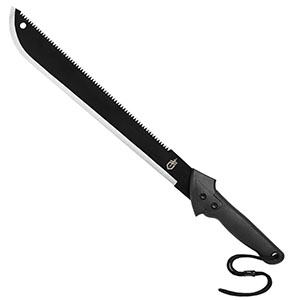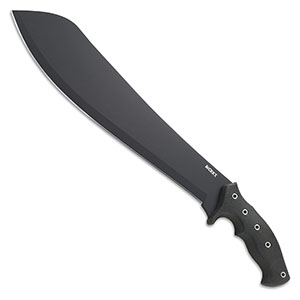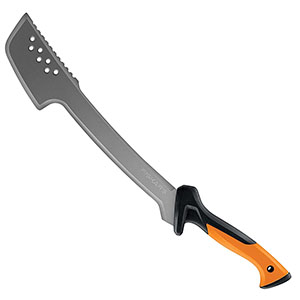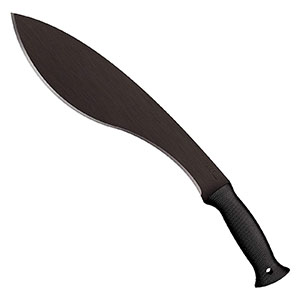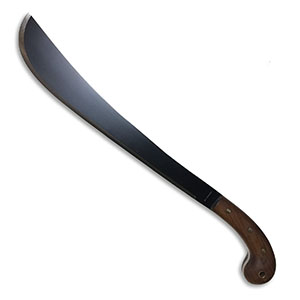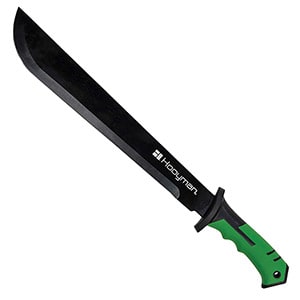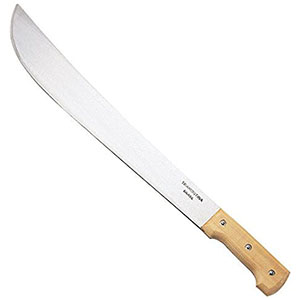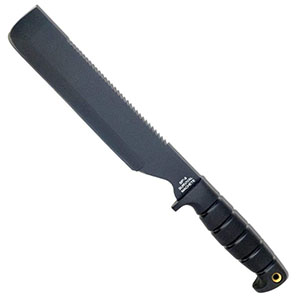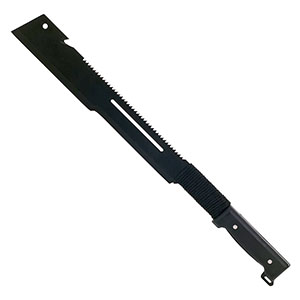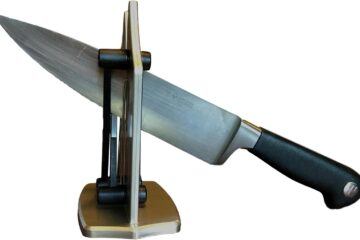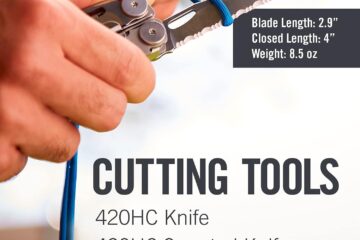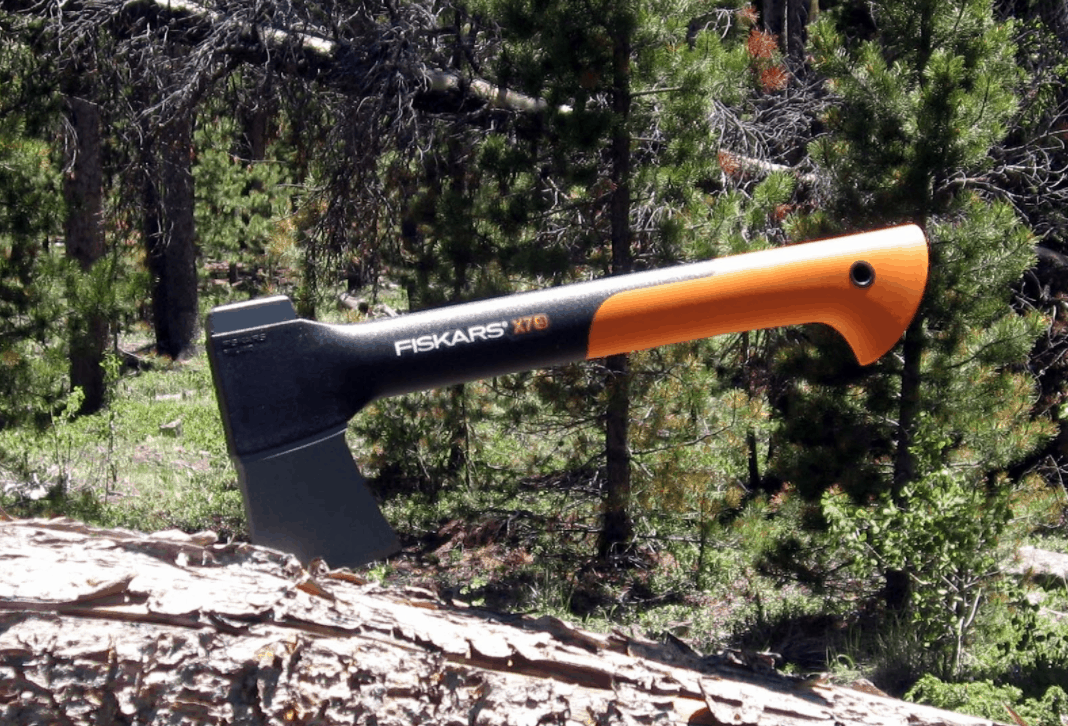Machetes have been around for centuries and are commonly used in agriculture, construction, property management, camping and a variety of other situations. In recent years they have become increasingly popular as a survival tool due to their versatility and overall effectiveness.
The name “machete” derives from Spanish, which betrays the fact that they originated in South America. There, the early Spanish settlers used them to clear the jungle, establish settlements and create cultivatable land. From South America they spread to many areas of the world, first for agriculture, then for construction purposes and today as an all-purpose outdoor tool.
With all the different machetes out there, it can be difficult to separate the wheat from the chaff. But don’t worry. We’ve done the legwork for you and compiled the following list of the 10 best machetes for 2022.
1. Gerber Gator Machete
Gerber has created a machete that is the most budget friendly option we reviewed. This machete is 25” overall, with a multi-purpose 15” fine edge blade on one side and an 18” high performance saw blade on the other. The blade is high carbon stainless steel with a gator grip handle.
This comfortable rubberized texture is designed to give added security and safety, even when wet. The machete also comes with a black 400 denier nylon sheath. If you have a place in the woods you’ll want to have something like this with you at all times. The dual edge nature of the Gator means you can use it for everything from clearing underbrush to cutting firewood to fending off aggressive wildlife. It won’t let you down on any count, or in any weather conditions.
2. CRKT Halfachance Parang Machete
The CRKT Parang style machete is made of 65Mn carbon steel with a black powder coat for extra corrosion protection. The drop point blade is ideal for chopping whatever vegetation you may get yourself into. This Halfachance also features an ergonomic handle that helps to ease fatigue over the course of a long day.
The machete also comes with a reinforced nylon sheath that allows you to carry the blade snug against your belt or dangling down, depending on your preference. With its tough, aggressive blade, impressive balance and comfortable, textured grip the Halfachance will give you more than half a chance of clearing away overgrowth on your property, or reducing game to manageable portions for transport home. Comes with a limited lifetime warranty on materials and workmanship.
3. Fiskars 29 Inch Machete Axe
The Fiskars 29 Inch Machete tosses traditional design cues aside and goes all-in on functionality. From the two-handed grip, to the serrated spine, to the axe-like blade head for chopping wood, this is a machete built to tackle whatever is in your way. Whether you’re a landscaper in a woody suburb, or own a getaway in the forest, Fiskars 29 Inch Machete Axe should be in your arsenal.
The blade is fashioned from corrosion resistant hardened steel that holds its edge better than most. You have the option of one or two-handed use, as well as the ability to push, pull, hack or saw, and the finger guard provides welcome protection for your precious digits. The machete comes with a handsome and durable nylon carrying sheath and a limited lifetime warranty.
4. Cold Steel 97KMS Kukri Machete
If you’re a fan of big, bold, aggressive tools the Cold Steel 97KMS Kukri is going to whisper sweet nothings in your ear. The Kukri has a very compelling profile that states in no uncertain terms that it means business. It follows through on its promise with a full tang, 1055 carbon steel blade that slices through brush like a hot knife through butter.
Landscapers, construction companies, bushcrafters, preppers and more are going to enjoy the effectiveness of this tool. And if you also want to use it as a means of defending the homestead, you will likely find it useful for that too. That is, if you have the stomach for that kind of close quarters mayhem.
5. Condor Golok Machete
The Condor Golok Machete is 19” long with a 14” blade. Although slightly on the smaller side, it’s lightweight blade makes it easier to wield with control. It is made of heavy duty 1075 high carbon steel and has a black powder epoxy finish for added rust protection and durability. It also has a walnut handle which gives it more of an authentic look.
If you want an affordable, durable machete to tend to the needs of your property, or to have in the pickup just in case you manage to bag substantial game on your next hunting trip, this is a great choice. This machete also comes with a 100% leather sheath as an added bonus to make it that much easier to carry. Throw in a limited lifetime warranty from the manufacturer and it’s hard to say no to the Golok.
6. Hooyman Bush Machete
The Hooyman Bush Machete brings machete design squarely into the 21st century. This is a very handsome implement that’s well-balanced and extremely effective at clearing away whatever is in your path. The 3CR13 corrosion resistant, full tang stainless steel blade is 20 1/4 inches long and made for chopping. It also manages to hold an edge through sustained use.
The handle on the Hooyman Bush Machete is ergonomically designed to accommodate your hand and features a no-slip surface that holds fast even in the worst conditions. Overall weight of the machete is just over 1 1/2 pounds and biased toward the blade tip so you get the most out of every swing. Comes with a very serviceable polyester sheath and is covered by a limited lifetime manufacturer’s warranty.
7. Tramontina Machete Wood
If you have a taste for the traditional consider the Tramontina Machete. We found it to be very effective at slicing through underbrush with minimal effort. No doubt that has to do with the center of gravity being so far forward. The blade is fashioned from corrosion resistant stainless steel and is 18 inches in length. It’s one of the best we tested for chopping wood.
With the weight being aligned so far forward it might take a bit of practice to perfect your swing. But be patient. The payoff is worth it. The wooden handle is also very ergonomically comfortable, although it lacks a bit of bite when the weather is wet or you’re sweating a lot. Not the best overall machete on our list, but one of the best dollar-for-dollar values.
8. Ontario Knife Company SP8 Machete
The Ontario Knife Company has designed a great all-purpose survival blade with their SP8. It has a 1095 black epoxy high carbon steel blade that is 10 inches long, making it compact and easier to handle. The wedge style tip and sawtooth back make this lightweight machete very versatile. It comes with a fitted nylon sheath and Kraton handle for added comfort and accessibility.
If you want more effortless control over your machete right out of the box, the Ontario Knife Company SP8 Machete is a solid choice. At 10 inches the blade is not long enough for serious bushwacking, but it’s more than adequate for odds jobs around the house. The serrated edge also compensates for the shorter blade by allowing you to saw your way through heavy cover or to cut firewood for the campsite.
9. Whetstone Cutlery Brute Super Machete
The Brute is all about providing you leverage to lean into those tough to remove objects. The black coated stainless steel blade is 13 3/4 inches long with a serrated spine for sawing through things that are too big to hack through. But the real attraction is the elongated handle with the cord wrap for two-handed chopping/sawing.
There’s a slot to cut cord, two tiers on the blade to handle different types of bush, and an eyelet at the blade tip for hanging the machete when you’re done. The pakkawood handle is also very comfortable and durable, though it’s not the grippiest on the market. The company throws in a nylon belt sheath for easy transport. A great, all-purpose, heavy duty machete.
10. Condor Tool & Knife Parang Machete
Another Parang style machete from Condor Knife & Tool, this blade is 17.5 inches of 1075 high carbon steel with a black epoxy powder coating. This machete has more of a traditional look compared to the CRKT Parang style that we reviewed, with a more traditional Parang handle design made of hardwood. This drop point blade comes with a heavy duty black leather sheath.
Because of the long, slender blade you will need to practice with this machete a bit if you’re going to get the most out of it, (and not endanger yourself). But once you get the hang of it you’re bound to appreciate the way it slices through moderate undergrowth. Because the blade is relatively thin, poor technique could lead to damage. So again, practice is important.
FAQs
What Is a Machete?
A machete is a hybrid blade that combines aspects of the sword and the knife into a single, formidable cutting tool. The machete usually (not always), has a broad blade that is heavier inch for inch than the sword blade. While it can, in theory, be used for self-defense it is not designed for that purpose. Instead, it is considered an agricultural tool and is designed primarily for clearing brush, and in some cases, harvesting crops like sugar cane.
When wielded properly a machete can make short work of vegetation. Because of this machetes were used extensively to chop through the dense tropical jungle during construction of the Panama Canal (1), and were also used by American forces in Vietnam to cut paths through, and establish camps in, the thick Southeast Asian jungle.
Who Needs a Machete?
Today, machetes are still used by soldiers, construction workers, and farm workers, but they have also become popular tools for homeowners, hunters, campers, and preppers. It is easy to see why. They are effective, affordable, and they don’t require an extension cord or gasoline to power them.
If you’re primarily interested in exploring the potential of the machete as a defensive weapon you are likely to be at least somewhat disappointed. A truly effective self defense weapon is one you can take with you pretty much wherever you go. Something like a knife or a handgun, both of which can be effectively concealed with little effort.
Machetes on the other hand are long and unwieldy. The only way you’ll be able to conceal one is if you’re wearing a long heavy coat, or you keep it in a large backpack. And good luck trying to retrieve your machete from a backpack while you are being assaulted. If you have a machete handy during a home invasion you might be able to use it to defend yourself. But that is a big if.
What Are Some Things to Look for in a Machete?
Blade style – There are several different styles of machete that were developed in different parts of the world to handle the vegetation in a particular area.
The Panga style is designed to have all the weight towards the front, which allows the blade to more easily chop woody plants and trees. The Barong style has more of the weight of the blade in the middle. These leaf-shaped blades provide more control when swung and were traditionally used in hunting and slaughtering animals.
The Kukri style is more of an all-purpose blade with 3 different sections. They have a pointed tip for stabbing and a wide blade for chopping and are a good blade for whittling and carving. Parang style machetes (also called Golok machetes) have a curved blade much like a scimitar, with the curve on both the spine and the edge. They are great for chopping woody vegetation.
Latin-style machetes, commonly referred to as ‘bush machetes’ have a straight back blade which creates a more even weight distribution and can easily be sheathed. This style is great for cutting down loose vegetation and makes an excellent all-purpose blade. Bowie machetes (named after American Frontiersman Jim Bowie (2), not the pop star) have a clip point ideal for skinning animals and are popular among hunters and survivalists.
Blade length – Machetes vary greatly in size, usually ranging from as small as 10 to longer than 28 inches. The smaller the blade, the less it will weigh. A shorter blade is easier to control and also easier to wear. A longer blade creates more momentum when swung and can clear a larger area with one swing. However, a long blade creates more of a hassle to transport. The average machete length is around 18 inches.
Blade thickness – The thickness of the machete blade can determine its durability and what type of vegetation or wood you can successfully chop. Most blades are around 1/8 inch thick. This provides a very thin blade that is easy to maneuver and is ideal for chopping through brush and jungle-like vegetation. There are machetes that are closer to the 1/4 inch thickness. These blades will be much stronger and can more easily chop woody vines and tree branches. However, the thicker blade means a heavier machete which is more difficult to wield.
Blade material – Carbon steel is a common material for machete blades and is an alloy of carbon and iron. The carbon makes the iron stronger and the blade will stay sharper for a longer period of time. Just keep in mind that a stronger blade is harder to re-sharpen. Stainless steel is carbon steel with nickel and chromium added to prevent the steel from rusting. Stainless steel generally requires less maintenance. But it’s softer than carbon steel which means it needs to be sharpened more frequently. There is also high-carbon stainless steel that holds its edge longer than standard stainless steel. These blades are more expensive, but are a great option for survival purposes.
Handle material – Wood has been the traditional handle material on machetes for centuries. It is still fairly common, but it is slowly being overshadowed by more modern materials. Those include Micarta (a composite of fiberglass, linen, canvas, paper and other materials), molded plastic, G10 (3), aluminum, and carbon fiber. You may also find bone and leather handles. The most important thing about the handle is that it’s comfortable and that it provides a sure, stable grip regardless of weather conditions or how much you are sweating.
Tang – A ‘full tang’ blade is a single piece of metal that extends all the way from the tip of the blade right through to the butt of the handle. Full tang is a must if you plan to use your machete to chop good size branches. If the machete is not full tang you run the risk of the blade separating from the handle while you’re hacking away at some tough underbrush.
Can You Use a Machete for Self-Defense?
Sure, but a machete is not an EDC knife. You don’t go out at night with your buddies with a machete slung from your waist. If you do, you’ll get about a block before The Man is all over you like a cheap suit. Basically, if you ever found yourself using a machete to defend yourself it would be because someone assaulted you while you were doing yard work, or while you were kicking back in your woodland retreat, or you were the victim of a home invasion and you had the machete handy. If you do wield it to defend yourself you’ll need a strong stomach because it’s going to make a mess of the other person.
Is There a Right Way to Swing a Machete?
In spite of being somewhat misunderstood, a machete is a tool, meaning there is indeed a right way and a wrong way to use it. You can just grab it and start swinging, but you’ll endanger yourself and any bystanders. You’ll also waste a lot of time and energy and wear yourself out in a hurry. The right way to wield a machete is to shake out your arm a bit to make sure you are nice and loose, and then to grab it firmly, avoiding a white knuckle death grip.
Before you swing check to make sure no one is anywhere near you, (that includes pets) and that there are no objects nearby that could interfere with your swing in any way. Once you’re sure you’re clear swing at a 45 degree angle downward. If you must swing it overhead do so at a 45 degree angle to the left or right. (Don’t ever swing the blade in a way that causes the swing to end near your body.) Swing with your whole arm, getting as much of your body into the swing as possible.
Are Machetes Legal?
Machetes occupy something of a legal grey area in the US. They are generally considered to be an agricultural tool and so are legal to own in every state and legal to carry in some states. But even states like Nevada, that are typically lenient when it comes to carrying weapons, forbid anyone from carrying a concealed machete (such as, in a backpack) without a permit (4).
In New York machetes are considered dangerous weapons and it is illegal to use them against another person (5). The bottom line is that machetes are governed by knife laws and knife laws vary from state to state. You will need to check the knife laws in your state before you attempt to move around in public with a machete.
Traveling with a machete is another matter. TSA considers it okay to transport a machete in a checked bag (6), within the US. It is forbidden, however, to have a machete in your carry on. It is also generally okay to buy a machete in a foreign country and bring it with you into the US, as long as you declare it and keep it in your checked bag. But you are likely to run into trouble if you try to bring a machete from the US into another country.
The Bottom Line
A machete is a long blade that is ideal for many situations. It’s no wonder that so many different cultures in completely different regions around the world all developed some version of a “machete” to better help their people chop vegetation and better cultivate the region in which they lived. These blades have served their purpose for thousands of years, and are a great blade for the modern-day survivalist.
